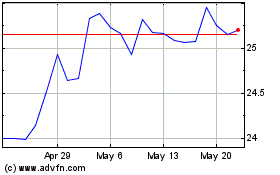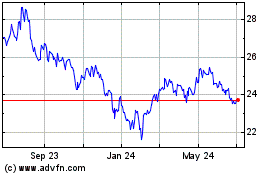China A-Shares ETF from KraneShares Hits the Market - ETF News And Commentary
March 12 2014 - 7:00AM
Zacks
After offering
CSI Five Year Plan ETF
(
KFYP) and
CSI
China Internet ETF
(KWEB) last
August, China-focused issuer KraneShares is all set to introduce
another China-centric ETF. The new fund –
KraneShares Bosera
MSCI China A ETF under the symbol of
KBA
–was launched on March 5, 2014 (read: Forget FXI: Try These Three
China ETFs Instead).
This time, KraneShares has joined with a local advisor, Bosera
Asset Management, for direct entry into the mainland market via an
initial renminbi qualified foreign institutional investor (RQFII)
quota of 1 billion RMB ($163 million).
KBA in Focus
This passively managed ETF looks to track the MSCI China A Index
which is a market capitalization weighted index designed to
indentify the equity market performance of large-cap and mid-cap
Chinese securities (“A Shares”).
A Shares are defined as the common stocks issued by companies based
in mainland China and are traded in renminbi (‘‘RMB’’) on the
Shenzhen or Shanghai Stock Exchanges (read: China A-Shares ETFs
Explained).
The index is equally diversified across the capitalization spectrum
with large, mid and small cap stocks, each accounting for 33.33% of
the portfolio. The Fund might allocate up to 20% of its assets in
investments that are excluded in the underlying index. KBA will
charge an expense ratio of 1.10% (see more on ETFs in the
Zacks ETF Center).
As of January 31, 2014, the underlying index was weighted heavily
toward the financial services (32.47%) sector with considerable
focus in industrials (16.42%) and consumer discretionary (12.6%)
sectors. The index comprises about 462 securities.
Top holdings for the index included China Merchants Bank A (2.84%),
China Minsheng bank (2.53%), and Ping an insurance (2.29%). Less
than 20% of the index portfolio is in the top 10 securities,
causing lesser concentration risk, especially considering that all
of the companies in the index belong to pretty diverse sectors.
How could it fit in a portfolio?
This ETF could be appropriate for investors seeking a new way to
play the high-flying financial, industrials and consumer
discretionary segments of the world’s second largest economy.
Though the recent indicators point toward the sluggishness
specifically in these sectors, the recent dip might open up a
buying opportunity thanks to long-term potential (read: China ETFs
Struggle on Weak Data, Bailout Speculation).
Notably, despite a recent run of soft data and an emerging market
lull on a potential acceleration in QE tapering, Chinese government
targets a 7.5% growth rate in 2014. Even after considering the
recent slowdown in China, the growth target seems pretty impressive
compared to many developed nations.
ETF Competition
Initially, China A-Shares market was blocked to many foreign
investors, but it is slowly beginning to open up. At present, there
are a handful of ETFs in the Chinese A-shares market that can be
accessed by global investors.
These are
Market Vectors China ETF
(PEK),
PowerShares China A-Share Portfolio
(CHNA) and the newly
launched
db X-trackers Harvest CSI 300 China A-Shares Fund
(ASHR).
Among the set, PEK is the oldest and CHNA is the cheapest option
(charging 50 bps in annual fees). The other two funds PEK and ASHR
charge investors 72 and 82 bps in fees, respectively. In such a
scenario, the newly launched KBA, looking to charge the highest at
1.10% in the Chinese equities ETF space, might face a tough time in
garnering investors’ assets.
Also, one cannot ignore
iShares China Large-Cap
ETF (
FXI) which is not based on China
A-Shares market, but still influences the space having amassed
about $5.5 billion in assets.
Bottom Line
Given the out-of-favor status of the China ETFs, it may be
difficult for this newcomer to gather assets in the initial phase.
Investors should note that most of the China ETFs (except some
small-caps and technology funds) have shed in the range of 0.60% to
11.83% in the year-to-date frame (as of March 4, 2014).
Having said this, we would like to remind investors that the
long-term outlook of the nation appears promising. The government
seems poised to remove its structural bottlenecks with a slew of
financial as well as demographic reforms which also include an
easing of the country’s infamous one-child policy (read: China ETFs
Jump on Government Reform Afterglow).
In fact, the fund launched on Chinese five-year plan –
KFYP – held up pretty well this year amid the
broader market slump, adding about 3.40% in 2014. Thus, though KBA
might not be a winner in the near term, it could be an intriguing
option for long-term investors.
Want the latest recommendations from Zacks Investment Research?
Today, you can download
7 Best Stocks for the Next 30
Days. Click to get this free report >>
DB-HRVST CSI300 (ASHR): ETF Research Reports
PWRSH-CHA A-S P (CHNA): ETF Research Reports
ISHARS-CHINA LC (FXI): ETF Research Reports
KRANS-C CHN 5YP (KFYP): ETF Research Reports
KRANS-C CHN INT (KWEB): ETF Research Reports
To read this article on Zacks.com click here.
Zacks Investment Research
Want the latest recommendations from Zacks Investment Research?
Today, you can download 7 Best Stocks for the Next 30 Days. Click
to get this free report
Xtrackers Harvest CSI 30... (AMEX:ASHR)
Historical Stock Chart
From Nov 2024 to Dec 2024

Xtrackers Harvest CSI 30... (AMEX:ASHR)
Historical Stock Chart
From Dec 2023 to Dec 2024
